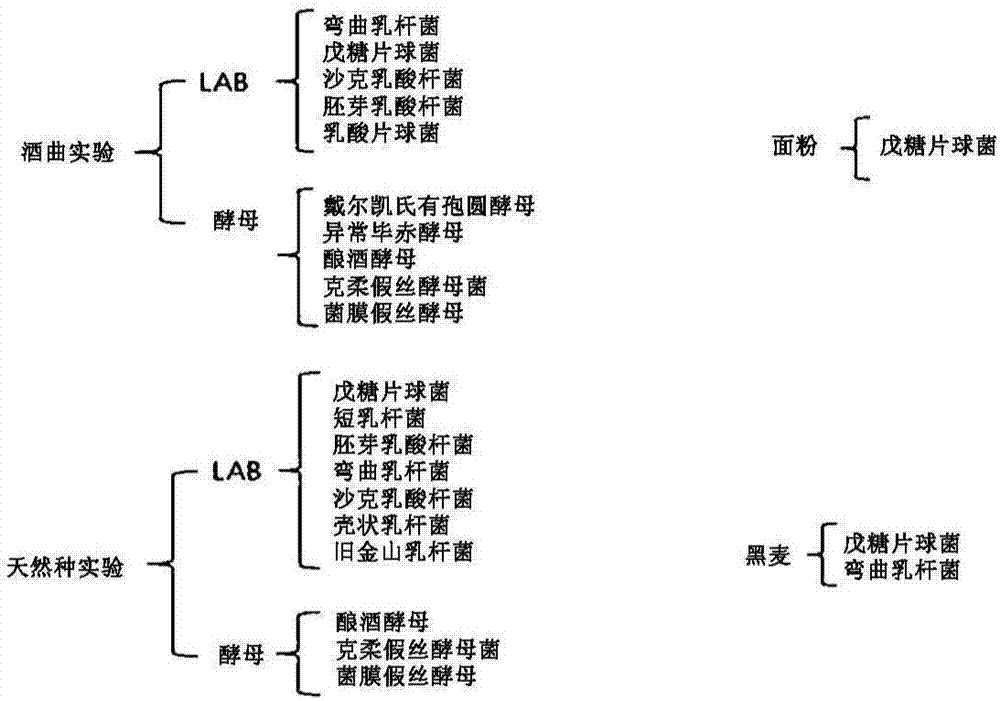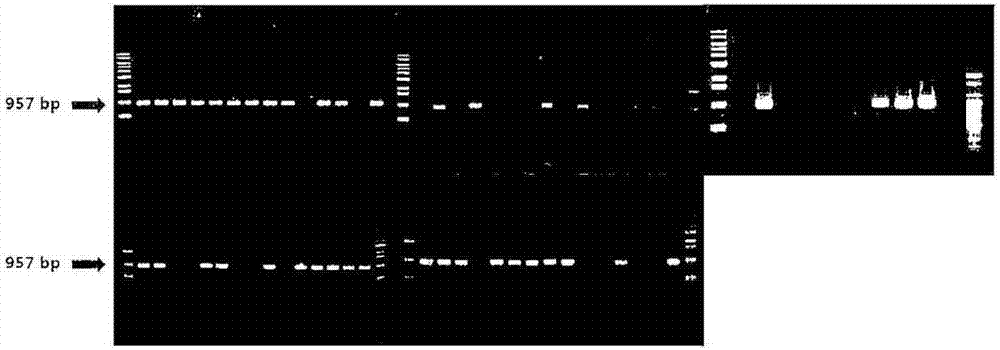Novel indigenous natural yeast and lactobacillus for baking bread isolated from traditional korean malt
一种面包、出色地的技术,应用在食品制备中使用的细菌、乳杆菌、细菌等方向,能够解决难以调整酸味强度、不符合品质特性、易发生变化等问题,达到出色产气力、硬度低、口感好的效果
- Summary
- Abstract
- Description
- Claims
- Application Information
AI Technical Summary
Problems solved by technology
Method used
Image
Examples
manufacture example 1
[0050] [Manufacturing example 1: Production of natural yeast added with koji (Korean-style sourdough with koji added)]
[0051] In order to extract microorganisms from koji, 450 g of water is added to 50 g of koji, and then cultured in an incubator at a temperature of 22°C and a humidity of 83% for 4 hours, and the wheat bran component of the koji is removed using a 100 mesh sieve to produce a starter extract filtrate.
[0052] As the first process for producing natural yeast, uniformly mix 400 g of starter extract filtrate, 950 g of flour, and 100 g of rye flour in 650 g of heating and cooling water at room temperature, and ferment for 48 hours at a temperature of 25°C and a humidity of 85%. starter, thereby producing a starter culture broth.
[0053] As the second process of making natural yeast (manufacture and subculture of natural yeast), 700 g of the above-mentioned starter culture solution, 950 g of flour, and 100 g of rye flour were evenly mixed in 1050 g of heating a...
Embodiment 1
[0054] [Example 1: Isolation and identification of microorganisms]
[0055] Prepare to isolate microorganisms from koji, rye, flour, and natural yeast (manufacturing example 1). Various raw materials 10g, 0.85% NaCl After putting into a filter bag, homogenization process was performed for 3 minutes with the homogenizer (stomacher). Then use 0.85% NaCl to carry out stepwise dilution again, after diluting to an appropriate concentration, by smearing to MRS (de Man Rogosa and Sharpe, Difco), SDB (2% Maltose, 0.3% Yeastextract, 1.5% Fresh yeast extract, 0.03% Tween80, 0.6% Caseinpeptone, pH 5.6) on the solid medium, so as to isolate the lactic acid bacteria, and by smearing to the YM with 0.35% sodium propionate (Sodim Propionate) (Yeast Malt extract) and PDA (PotatoDextrose Agar) solid medium to isolate yeast.
[0056] The above-mentioned MRS was cultured statically at 37°C, and SDB, YM and PDA medium were all cultured statically at 30°C. Afterwards, in order to obtain a sin...
Embodiment 2
[0061] [Example 2: Isolate Lactobacillus San Francisco (L.sanfranciscensis) from natural yeast]
[0062] In this example, L. sanfranciscensis was isolated from a natural yeast (Korean-style sourdough with koji added), and a PCR unique to L. sanfranciscensis was designed for this purpose.
[0063] The whole genome sequence of Lactobacillus San Francisco was revealed in 2011 (Rudi F Vogel, Melanie Pavlovic, Matthias A Ehrmann1, Arnim Wiezer, Heiko Liesegang, Stefanie Offschanka, Sonja Voget, Angel Angelov, Georg BoWolfgang Liebl (2011) Genomic analysis reveals Lactobacillus sanitas raditional microbaccenscensis CellFactories.10(Suppl1): S6), and use this sequence to explore the genetic map of Lactobacillus San Francisco TMW 1.1304 and the genetic gene database that does not overlap with other strains, and screen out LSA_02510 hypothetical protein (hypothetical protein) .
[0064]PCR primers were designed in such a way that they would not be amplified in the genetic genes of oth...
PUM
 Login to View More
Login to View More Abstract
Description
Claims
Application Information
 Login to View More
Login to View More - Generate Ideas
- Intellectual Property
- Life Sciences
- Materials
- Tech Scout
- Unparalleled Data Quality
- Higher Quality Content
- 60% Fewer Hallucinations
Browse by: Latest US Patents, China's latest patents, Technical Efficacy Thesaurus, Application Domain, Technology Topic, Popular Technical Reports.
© 2025 PatSnap. All rights reserved.Legal|Privacy policy|Modern Slavery Act Transparency Statement|Sitemap|About US| Contact US: help@patsnap.com



